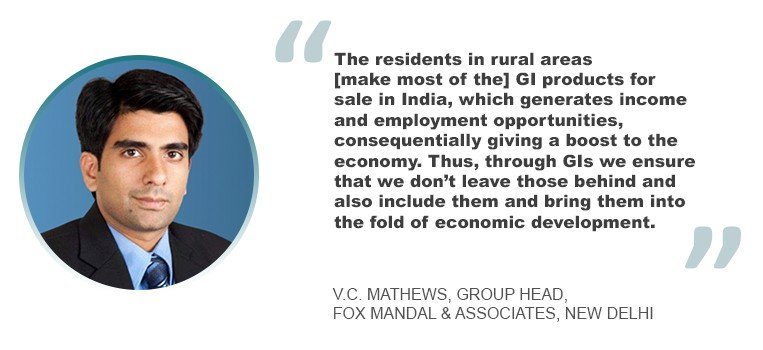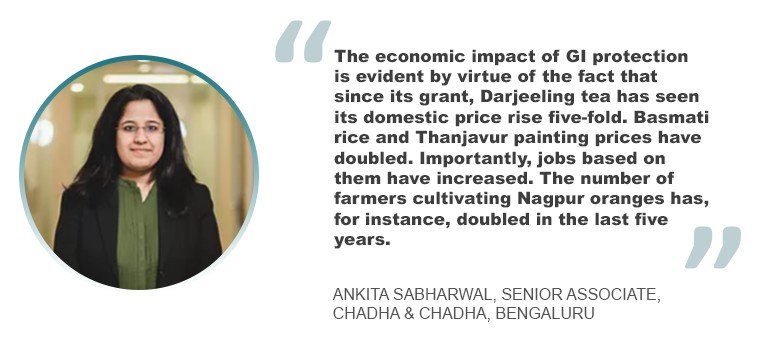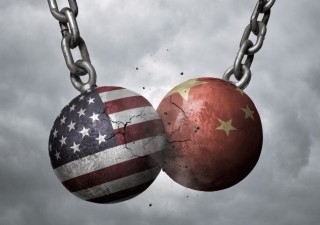The economic impact of geographical indications in India
31 August 2023

The recent discussion between the European Union and Thailand for an ambitious, contemporary, and fair free trade agreement (FTA) with sustainability at its core has brought to light the crucial role that the Indo-Pacific area plays in the EU’s trade agenda. This has led to opening the door to closer economic connections with Southeast Asia’s second-largest economy and enhancing the EU’s strategic involvement with this developing region.
The FTA will address a variety of concerns, including the protection of intellectual property rights, particularly geographical indications, to increase commerce and investment.
India, for one, has significant rich ancient traditional knowledge in the field of handicrafts and handloom manufacture and many other fields. Protection of folklore encourages cultural diversity, contributes to economic development, and helps to preserve cultural heritage.

Channapatna toys, made in the town of Channapatna in Karnataka, are a popular form of wooden toys and dolls. The toys’ history dates back more than two centuries. It was granted its geographical indication registration in 2004, resulting in Channapatna being known as Gombegala Ooru, or toy-town, of Karnataka. (Photo: HP Nadig, CC BY-SA 3.0)
Among these include Channapatna toys from Karnataka, Pochampalli ikkat (saris) from Andhra Pradesh, Mysore silk from Karnataka and Kancheepuram silks from Tamil Nadu which are enjoyed by Indians and have a high value internationally as well. Protection via GIs gives a livelihood to thousands of artisans, helps in enhancing income and protects the traditional knowledge and encourages rural development. Hence, GIs are regarded as an effective tool, as they recognize the rights of the original traditional knowledge holder and prevent a third party from claiming rights over it.
“[This is true] especially in the context of the United Nations’ 2030 Agenda for Sustainable Development and its 17 Sustainable Development Goals (SDGs), which has pledged to ensure sustained and inclusive economic growth, social inclusion, and environmental protection,” says V.C. Mathews, group head at Fox Mandal & Associates in New Delhi. “Their core principles being leaving no one behind and inclusiveness, which talk about reaching out to people in need and deprivation and call participation from all segments of the society to contribute to its implementation.”
He adds that India has a treasure trove of traditional knowledge, especially among the rural areas and tribes.

“Since most of the geographical regions are surrounded in rural areas, it creates more chances for rural development,” he says. “The advantages of geographical indications are to sustain monetary activities of the people as well as to develop their standard of living. The residents in rural areas [make most of the GI products for sale in India], which generates more income and employment opportunities, consequentially giving a boost to the economy. Thus, through GIs we ensure that we don’t leave those behind and also include them and bring them into the fold of economic development.”
With the UN’s Sustainable Development Goals addressing the global challenges related to poverty, inequality, climate, environmental degradation, prosperity, peace and justice, governments are working to meet the set goals for sustainable development by the target year of 2030, effectively trying to improve the quality of life of citizens.
“It is widely believed that actual economic growth lies in urbanization,” he says. “Already half of the world’s population lives in urban areas, which is expected to rise in future. In India, rural-to-urban migration is growing at a phenomenal rate, and the pace is expected to accelerate. Hence, the path to sustainable development must pass through cities.”
To prepare for this migration and fast-track India’s development, the Indian government announced the Smart Cities Mission in 2015 with a view to provide cities that offer good basic infrastructure, a clean and sustainable environment with ‘smart’ applications using technology, information and data. Smart architecture, which is in sync with wind and natural light resources, will not only help control air and water pollution but also encourage the use of construction material that is eco-friendly and which should not create ecological imbalance.
As the wave of technology sweeps through the country, the government is harnessing its power for development while ensuring that sustainability and development go together.
The driving factor of economic development

Nagpur orange is a variety of mandarin orange grown in Nagpur, Maharashtra, known for its pockmarked exterior and sweet, juicy pulp. It received its geographical indication registration in 2014. (Photo: Cherishsantosh, CC BY-SA 4.0)
In a study conducted by the Organization for Economic Co-operation and Development (OECD), experts suggest that the two main factors that influence economic development are market access and differentiation.
“Geographical indications create differentiation based on product ‘qualities’ and consequently contribute to the creation of niche markets,” says Ankita Sabharwal, a senior associate at Chadha & Chadha in Bengaluru. “This serves as the main economic rationale in the protection of GIs. The economic impact of GI protection is evident by virtue of the fact that since its grant, Darjeeling tea, for example, has seen its domestic price rise five-fold. Moreover, basmati rice and Thanjavur painting prices have doubled. Importantly, jobs based on them have increased. The number of farmers cultivating Nagpur oranges has, for instance, doubled in the last five years.”

The history of Pochampalli ikkat (saris) is shown in this 1895 painting by German artist Hermann Linde. The saris are made in Bhoodan Pochampally, in Telegana State, and are today worn by Air India flight attendants. Pochampalli ikkat was registered as a geographical indication in 2005.
Sabharwal says that the Pochampalli saris mentioned earlier are a classic example of the economic impact GIs have on an economy. Pochampalli saris are made from a unique age‐old fabric (silk, cotton or combinations thereof) woven in the Nalgonda and Warangal districts of the Indian state of Andhra Pradesh. The fabric is made by a process of tying and dying the yarn prior to weaving. The industry accommodates over 1,000 weaving households in Pochampalli and an estimated 5,000 weavers, working on approximately 2,000 traditional pit looms.
However, in the 1990s, the art of creating products out of Pochampalli ikkat witnessed a striking decline. Low productivity of traditional pit looms and negligent market efforts contributed to the obliteration of the industry. While the creation of a warp of eight saris made of this fabric took more than 45 days, wages provided to the weavers were excruciatingly low. In 2007, the average income provided to a weaver for completing a warp of eight saris would be as low as Rs1,500‐2,500. In 2007, US$1 equalled Rs41, meaning most weavers earned US$36-48 dollars for six weeks’ worth of work.
Eventually, in assistance with the Pochampally Handloom Tie & Dye Manufacturers Association, Pochampalli ikkat was awarded GI registration on December 31, 2004, and became the first handloom product to be registered as a GI in India. After the registration, the fabric received huge publicity, which created immense demand. The demand for Pochampalli saris increased by 15‐20% in 2008, increasing the weaver wages by up to 20%.
The impact of GIs on the economy of a nation is further illustrated by the fact that the European Union has a US$87 billion GI economy, Sabharwal notes.
“With more and more products being protected by GIs, the future of GIs in India is evident by the entry of conglomerates into the space,” she says. “An example of the same is Amazon’s local-to-global programme which has taken Indian producers and their products such as Delta Leather Corporation’s leather and SVA Organics’ organic products to markets in over 200 countries, increasing the demand for their products and company size by as much as 300 times,” she says.
“In two years, as of the first quarter of 2021, Amazon exported such ‘Made in India’ goods worth US$2 billion. By virtue of this initiative, GI products will witness an unprecedented outreach. The same is a testament to the fact that GIs in India will play a major role in the growth of the Indian economy soon.”
- Excel V. Dyquiangco






